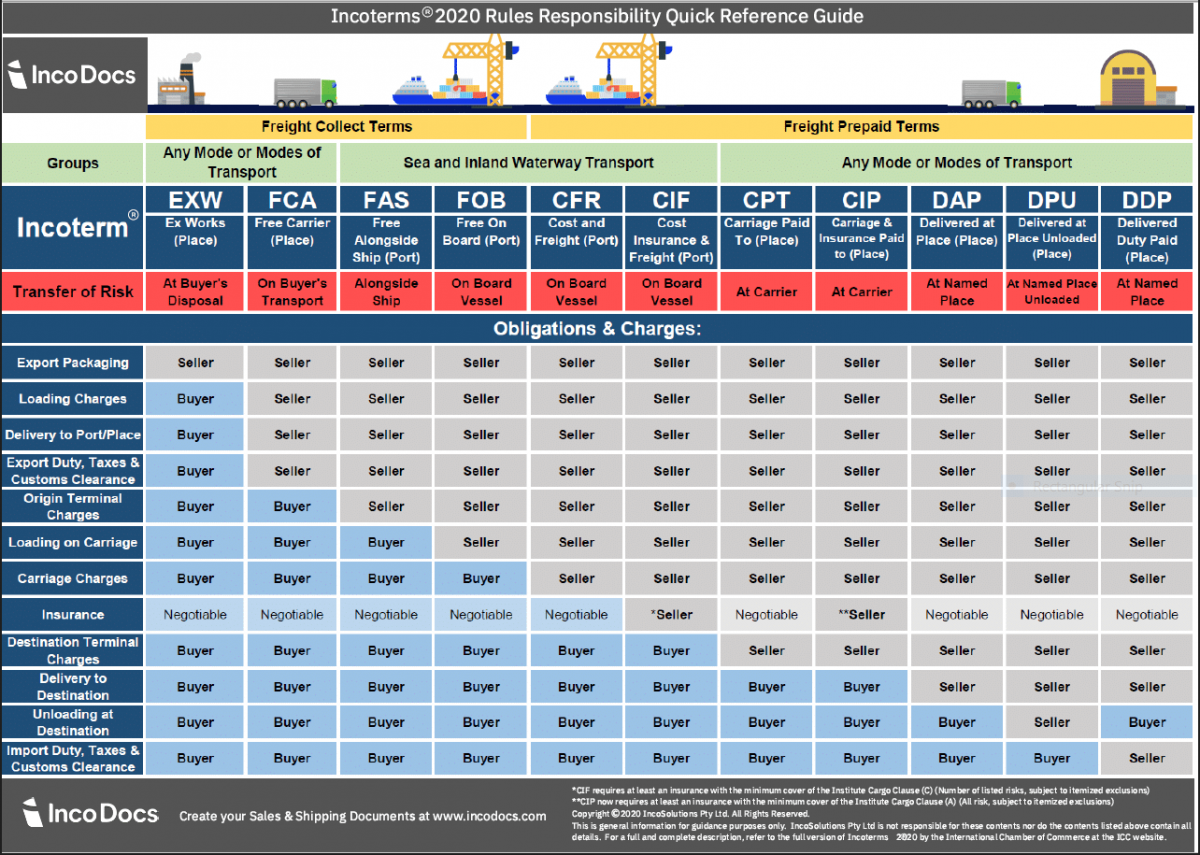When engaging in international trade, it is crucial to have a clear understanding of the terms and conditions that govern the responsibilities and risks between buyers and sellers. Incoterms (International Commercial Terms), developed and maintained by the International Chamber of Commerce (ICC), provide a standardized set of rules that define these obligations. In this blog post, we will delve into the essential aspects of Incoterms 2020, exploring how they impact global trade and help ensure smooth and transparent transactions.
What are Incoterms?
Incoterms are a set of three-letter trade terms that facilitate smooth communication and transaction processes between importers and exporters. The latest version, Incoterms 2020, defines the responsibilities of both parties, clarifying who is responsible for various stages of the shipment and when the risk transfers from the seller to the buyer.
Key Changes in Incoterms 2020:
Incoterms 2020 brought about several crucial updates from its predecessor, Incoterms 2010. Some of the notable changes include:
• Incorporation of Bill of Lading with FCA: In Incoterms 2010, Free Carrier (FCA) could be used for any mode of transport. However, in Incoterms 2020, FCA includes the option to issue a Bill of Lading, making it more suitable for maritime transport.
• DAT to DPU: Delivered at Terminal (DAT) was changed to Delivered at Place Unloaded (DPU) to better reflect the unloading location, which may not necessarily be a terminal.
• Security Requirements: Security-related clearances and obligations have been strengthened in Incoterms 2020 to address the evolving global security landscape.
An Overview of Incoterms® 2020: Understanding 11 TradeTerms, Including 7 Suitable for Any Mode of Transport.
1. EXW – Ex-Works or Ex-Warehouse
In this trade term, the seller makes the goods available to the buyer at the seller’s premises or another specified location, such as a factory or warehouse. The seller is not responsible for loading the goods onto any collection vehicle or handling export clearances, if applicable.
2. FCA – Free Carrier
Under FCA, the seller delivers the goods to the carrier or a person nominated by the buyer at the seller’s premises or another designated location. It is crucial to specify the exact point within the named place of delivery, as the risk transfers to the buyer at that specific point.
3. FAS – Free Alongside Ship
When using FAS, the seller’s responsibility ends when the goods are placed alongside the vessel nominated by the buyer at the named port of shipment. The risk of loss or damage to the goods transfers to the buyer at this point, and the buyer assumes all costs from thereon.
4. FOB – Free On Board
FOB entails the seller delivering the goods on board the vessel nominated by the buyer at the named port of shipment or procuring goods already delivered to the vessel. The risk of loss or damage to the goods shifts to the buyer once the goods are on board the vessel, and the buyer becomes responsible for all costs after this point.
5. CFR – Cost and Freight
Under CFR, the seller is responsible for delivering the goods on board the vessel or procuring goods already delivered to the vessel. The risk of loss or damage to the goods transfers when the products are on board the vessel. Additionally, the seller must contract for and cover the costs and freight required to bring the goods to the named port of destination.
6. CIF – Cost, Insurance and Freight
Similar to CFR, CIF involves the seller delivering the goods on board the vessel or procuring goods already delivered to the vessel. The risk of loss or damage to the goods transfers when the products are on the ship. However, in addition to covering costs and freight, the seller is also responsible for insuring the goods during the carriage.
7. CPT – Carriage Paid To
With CPT, the seller delivers the goods to the carrier or another nominated person at an agreed place, if specified in the agreement. The seller must also bear the costs of carriage necessary to bring the goods to the named destination.
8. CIP – Carriage and Insurance Paid To
CIP carries the same responsibilities as CPT, with the added provision of insurance against the buyer’s risk of loss or damage during the carriage. The seller, however, is required to obtain only minimum insurance coverage, and any additional insurance desired by the buyer must be arranged expressly.
9. DAP – Delivered At Place
Under DAP, the seller delivers the goods to the buyer at the named place of destination, ready for unloading from the arriving means of transport. The seller assumes all risks involved in bringing the goods to the named place.
10. DPU – Delivered At Place Unloaded (replaces Incoterm® 2010 DAT)
DPU is a replacement for the former Incoterm® DAT (Delivered At Terminal). Here, the seller delivers the goods at the named place of destination, once they are unloaded and made available to the buyer. The seller bears all risks related to bringing and unloading the goods at the named destination.
11. DDP – Delivered Duty Paid
DDP places the full responsibility on the seller, who must deliver the goods at the named destination, cleared for import, and ready for unloading from the arriving means of transport. The seller is responsible for all costs and risks involved, including clearing customs for both export and import, paying any applicable duties, and completing all customs formalities.
Selecting the Right Incoterm:
Choosing the appropriate Incoterm is crucial, as it directly impacts the cost, risk, and responsibility borne by both parties. Factors to consider when selecting an Incoterm include the nature of the goods, the mode of transport, the destination country’s regulations, and the level of trust between the buyer and seller.
Benefits of Using Incoterms 2020:
Using Incoterms 2020 offers numerous advantages to businesses engaged in international trade:
• Clear Responsibilities: Incoterms clearly outline the obligations of both parties, reducing misunderstandings and disputes.
• Risk Allocation: The terms define the point at which the risk of loss or damage shifts from the seller to the buyer, enabling better risk management.
• International Consistency: Incoterms provide a globally recognized standard for trade practices, promoting consistency in cross-border transactions.
• Cost Estimation: Businesses can more accurately calculate costs associated with transportation, insurance, and other trade-related expenses.
Incoterms 2020 plays a fundamental role in facilitating international trade by providing a common language for buyers and sellers to define their responsibilities. Understanding these trade terms is crucial for ensuring smooth and transparent transactions while mitigating risks. By incorporating the appropriate Incoterm into their contracts, businesses can streamline their operations and focus on expanding their presence in the global marketplace.
Thompson, B. (2020, January 20). Incoterms 2020 explained: The complete guide. Retrieved from https://incodocs.com/blog/incoterms-2020-explained-the-complete-guide/




